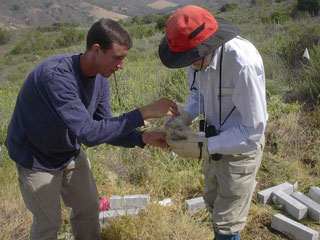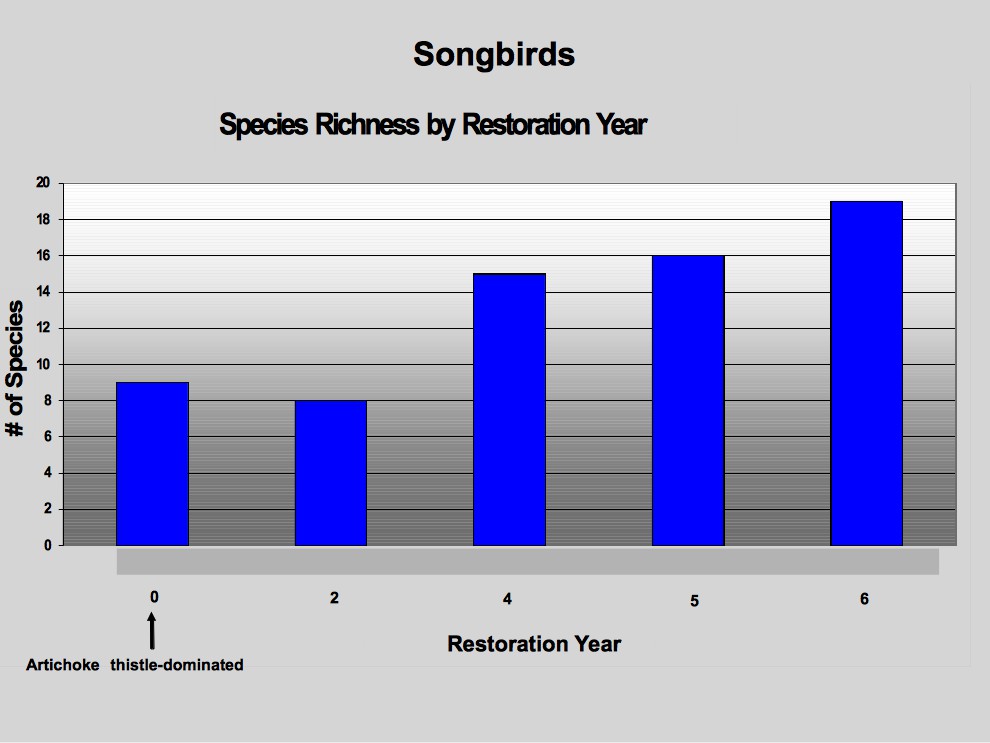Effects of Restoration on Wildlife
Project Introduction
At Audubon California’s 4000-acre Starr Ranch Sanctuary, we take an active adaptive (i.e. research-based) approach to land management. We are currently using mechanical and physical methods, tested in experiments during 1997-98, to control artichoke thistle (Cynara cardunculus) in approximately 700 acres of degraded and native grassland sites throughout the Ranch. Artichoke thistle is on the California Department of Food and Agriculture "B" list of noxious weeds, which contains some of California’s most invasive and wide-spread wildland pest plants. By the second year of artichoke thistle control, weed cover is considerably reduced and we initiate restoration to either native perennial grassland (450 acres) or coastal sage scrub (250 acres).
 The world-wide range of coastal sage scrub is in a discontinuous, narrow strip of coastal Alta and Baja California (Westman 1983). Coastal sage scrub is increasingly threatened by urbanization in southern California and has become an endangered southern Californian vegetation type (O’Leary 1990). Sage scrub is the preferred nesting habitat of the coastal California Gnatcatcher (Polioptila californica californica), which was federally listed as a threatened species in 1993. At Starr Ranch, we preserve approximately 2063 acres of pristine coastal sage scrub that support at least 22 nesting pairs of California Gnatcatchers (Taylor 1992).
The world-wide range of coastal sage scrub is in a discontinuous, narrow strip of coastal Alta and Baja California (Westman 1983). Coastal sage scrub is increasingly threatened by urbanization in southern California and has become an endangered southern Californian vegetation type (O’Leary 1990). Sage scrub is the preferred nesting habitat of the coastal California Gnatcatcher (Polioptila californica californica), which was federally listed as a threatened species in 1993. At Starr Ranch, we preserve approximately 2063 acres of pristine coastal sage scrub that support at least 22 nesting pairs of California Gnatcatchers (Taylor 1992).
In spring 2004 we offered a class that trained volunteers in a pilot study to investigate effects of coastal sage scrub restoration on wildlife (small mammals and birds). In summer 2004 we initiated a long-term study, which is designed to begin with baseline data in sites heavily invaded by artichoke thistle that will eventually be restored to coastal sage scrub. Long-term monitoring of vegetation, small mammal, and songbird populations will continue indefinitely through the coastal sage scrub restoration process.

Songbird species richness over a restoration chronosequence using spot mapping, from an artichoke thistle-dominated site (>60% cover) through years two, four, five, and six of coastal sage scrub restoration. In the oldest restoration site we detected birds typical of closed canopy shrublands such as Lazuli Bunting that were not detected in the artichoke thistle-dominated site. This study was terminated because of human impacts to the fragile shrubs in older restoration sites.

Numbers of small mammals captured and released over time using Sherman traps in two matched sites. One site was a natural coastal sage scrub (CSS) stand (“pristine”; 26 years postfire) and the other site was a CSS restoration site that progressed from >90% artichoke thistle cover at baseline through the 4th season of restoration. All small mammal species were native (species of Peromyscus, Neotoma, Reithrodontomys, and Microtus). The fluctuating numbers of small mammals in the natural CSS site are typical of native small mammal populations. This study was terminated because of human impacts to the fragile shrubs in older restoration sites.
